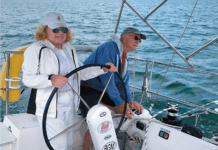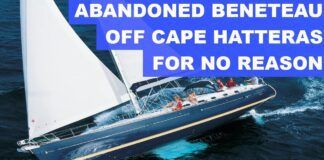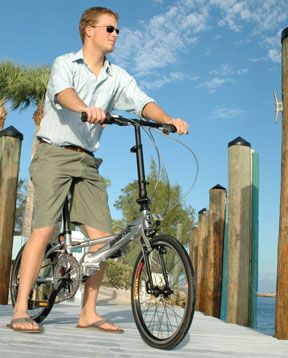
Not so long ago, if you wanted to bring a bike along cruising, you had to partially disassemble it to fit below, then try to reassemble the ball of rust when you were ready to use it again.
Fortunately, there have been some marked improvements in the bicycle industry in last decade, particularly in the niche market of foldable bicycles, once derided by purist as expensive, clumsy and soft on performance. Several manufacturers have been refining them for the last 20 years and now offer bikes constructed of more sea-friendly materials with folding systems that allow easier stowage, without affecting the frame’s rigidity too much.
We evaluated four models all under $700. We selected a group of bikes that represent the three most typical uses for a cruising sailor: long-distance road riding, trail riding, and cruising. We paid close attention to the materials used, the strength and efficiency of the folding system, and portability. Ergonomics and performance were also considerations.
Dahon
Dahon (www.dahon.com) is the largest manufacturer of folding bicycles in the world. David Hon, a physicist and company founder, began experimenting with folding bike technology in the early 1980s. Dahon has offices in California and Taiwan, a manufacturing plant in Macau, and a 28-model product line. We trailed the Cadenza ($500), a full-size road bike new to the market, and the Helios ($580), an eight-speed cruiser with 16-inch wheels and a half-sized aluminum frame that compensates with an extra-long seat tube and handle bar stem.
With its skinny tires and light-weight aluminum frame and components, the Cadenza is a fast road bike that affords a rider an upright posture, as on trail bikes and cruisers. It’s ideal for long-range riding on asphalt, although more serious riders will be disappointed with it’s minimal 16-speed gearing and somewhat fickle grip shifters. The addition of a cargo rack would make it a very useful tourer/transporter.
The carbon-wrapped aluminum handle bar and ergonomic bar ends are notable features for this mid-priced bike, as is the quick-release folding stem. One component we’d like to see changed is the WTB Rocket V seat, which was a bit uncomfortable for any serious long-distance riding.
The Helios has the smallest folded size of the all of the bikes we evaluated. Dahon carries several other models with small frame geometry that also will fit easily through the companionway and be stowed in a sail locker or beneath a V-berth.
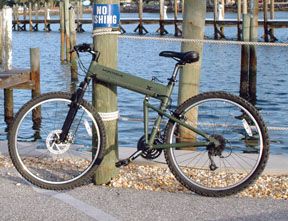
The Dahons employ the most effortless folding system of the group. A hinge with a tensioning bar separates the main frame tube with the small upper tube, which links to its mating part with a metal coupling. This system folds the bike in half symmetrically, which makes it easier to store because it will sit upright and you don’t have to remove the wheels. However, because the frame’s tubing is separated, these bikes seem more susceptible to frame-wear from excessive weight or impact. While riding, we noted the faint sound of metal on metal as the tubes shifted over a bump or when we were pumping hard uphill.
Montague
The Montague Paratrooper ($645. www.montagueco.com) is a trail-ready folding bicycle for those who spend more time off the road than on it. It’s the product of a joint venture between Montague, a Massachusetts-based company in business since the late 1980s and the Department of Defense equipment research and development arm. They’ve created a foldable all-terrain bicycle that could be deployed with a paratrooper—slung on a releasable line so the bike lands ahead of the jumper, reducing his landing weight.
The bike features a front disc break, front shocks, knobby tires, a matte green military paint job and 24-speed rapid-fire shifters. The folding system maintains the frame’s integrity by swinging the bike’s rear quarter to the fore frame with a hinge that doesn’t split the tubing. The folding hinge is controlled by a single quick-release lever that has two locking systems if you forget to clamp it down to the closed position. Overall, folding is easy, but you need to remove the front wheel to really shrink it down.
We have some small gripes with the Paratrooper. It arrives in a box 95 percent assembled. All you have to do is attach the pedals with a wrench included in the package. But the pedal studs and cranks are made with metals of different hardness and because the studs have reverse threading, cross threading is a possibility. (It happened to us.) The Paratrooper also has the largest folded size of the group. Not surprisingly, it was our most stable beach-comber—but cruisers would have to have real off-road ambitions to justify devoting the space needed to store it.
West Marine
The Port Runner from West Marine ($296, www.westmarine.com) is a solid bike for its relatively inexpensive price tag. Like the Helios, it has a small aluminum frame, 16” wheels, elongated handlebar stem and seat tube, and folding pedals. It has six-speed grip-shift gearing to the Helios’ eight. Its cargo rack with built-in bungee cords is a very nice addition, although it does increase its folded size; the Port Runner is the only bike in our group that came with one. This rack has a 23 lb. weight limit and will accommodate a jerry can or milk crate full of groceries.
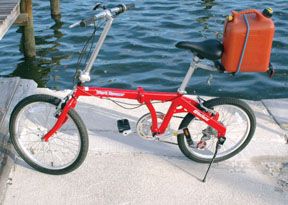
The folding mechanism consists of hinge that splits the single main frame tube that is secured with a single quick-release, which has a locking mechanism that will loosely hold the frame together if you forget to put it in the closed position. The handlebar stem folds down, but instead of using a quick-release like the Helios, the Port Runner’s hinge is secured with a wedge that is screwed into place.
The Port Runner offers more utility than the Helios and rides nearly the same, but weighs more, requires more space, and doesn’t feature the same high-end components.
Recommendations
Whether you like to stray off the beaten path, cover 20 miles in a day on smooth pavement, or just pedal to the store and back, there’s a foldable bike that suits your riding habits. We feel that all of the bikes we tested will hold up in a marine environment with regular preventative maintenance that will require the occasional replacement of small parts due to corrosion.
In choosing the right bike to bring aboard, considering the amount of space you can devote to it should be a top priority. For their general ease of portability, we’re inclined to go with the small frame cruisers. Of the group of folders we evaluated, the Dahon Helios is our top pick because it has the smallest folded size, lightest weight, and best array of high-end composite components. However, the Port Runner, at half the cost and nearly the same functionality and more utility, is our best value.
We like both the Montague Paratrooper and Dahon Cadenza. These full-sized bikes will not disappoint, if you have room to stow them.
































